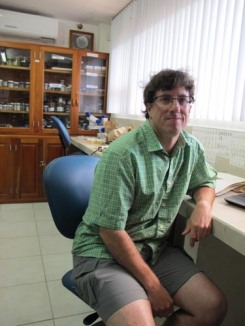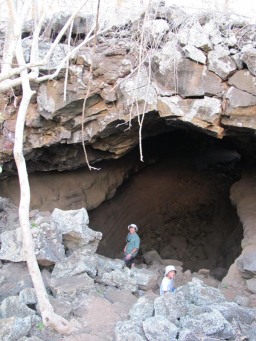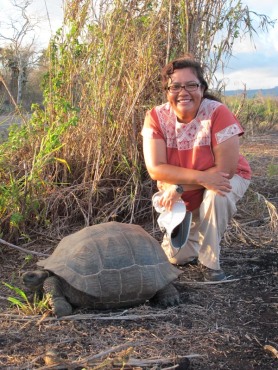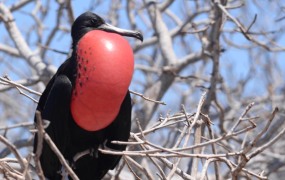Having a slow Saturday around the house today. Actually it’s laundry day. We haven’t been able to do laundry all week which with two small kids can be a big deal. The owner of the house we are renting is having construction done behind the house to add on more space. So..the back is all torn up and the laundry area taken apart and finally put up again in another area of yard. And internet’s working a little better today. A pattern I’ve seen is that it tends to be a little faster on weekends. So a little reading of news – but honestly the state of my country right now is not very uplifting. So back to plants and my current life on a tropical island.
This week has me thinking lots about phylogenetic relationships and how plants change as they invade islands. Thus this small piece of algae I picked up while swimming the other day with its clear dichotomous branches made me think of a phylogenetic tree.

Some of the changes are quite evident in the Galapagos flora. A trend toward woodiness from herbaceous ancestors is common as is a trend toward non-showy flowers. Most of the native species have relatively drab flowers – the large showy flowers you can see in town on along roadsides are predominantly introduced from other tropical areas. One exception to this however is Opuntia which has large yellow flowers pollinated by the only native bee in the islands, the Galapagos Carpenter Bee (Xylocopa darwini). But in an isolated oceanic island with few animal pollinators there is little need for most plants to advertise for floral visitors.

Xylocopa darwini visiting a flower of Opuntia echios
I’ve been continuing my regular work in the herbarium. Mostly finished with the Froelichia work that can be done with collected specimens and I’m just waiting for the final approval of our collecting permits to head out for field work. I’ve also been able to develop a new collaborative study with staff here at the Charles Darwin Research Station – more on that as it develops – it should be exciting as I think we may have some new undescribed taxa.


Emiliano has also been joining me in the herbarium off and on. I look at specimens and examine tiny flowers under the microscope and he sits at a table and draws. He made some beautiful drawings of herbarium specimens and of some large seeds on display in the collection! He doesn’t say it but I think he enjoys going with me for the air conditioning – a must for maintaining a collection in a hot and humid environment!
The last couple weeks we’ve been continuing to explore the island of Santa Cruz and have started to take some short trips to a couple other islands. Lava tubes have been a favorite, particularly for Emiliano.

Ross and Emiliano exploring a lava tube just north of Puerto Ayora
We’ve also come to the conclusion that giant tortoises are very much like deer are in Colorado. They are common and you don’t always stop to see them.

Aurea and a friend along the main road just north of Puerto Ayora
We’ve taken a couple boat trips to the nearby islands of Seymour Norte and Bartolomé. We feel a little guilty in that we have not taken Ian with us, but nothing is handicap accessible and with his disabilities and being unable to walk it would be very dangerous to move in and out of inflatable boats bobbing on the ocean and with the heat he would not enjoy it. We have luckily been able to find a nice woman to babysit for us when we are out for the day.

Sailing NW of the island of Santa Cruz. The small island of Daphne Minor is above our heads.
The excursions have been great for seeing wildlife. Frigate birds, blue footed boobies, land iguanas, Galapagos Penguin (the only penguin occurring into the northern hemisphere), sea lions, dolphins, and Aurea saw a Sea Cucumber while snorkeling – she said it didn’t look like much but I really wanted to see one.

Frigatebird

Blue-Footed Booby

The required photo from the top of Isla Bartolome looking toward Sullivan Bay and Isla Santiago
Plants seen during these excursions are generally your common beachside species. On Bartolomé which is almost barren of plant life I did see the genus Tiquilia (Boraginaceae) (likely T. nesiotica but the definitive characters to distinguish species is the surface of the nutlet and character of the stem pubescence which I don’t remember) which is one of the early colonizers on this barren landscape. Yea, I love beautiful flowers but there’s something that attracts me to the plants trying to eek out a life in the harshest of environments.

Tiquilia sp. – Isla Bartolome
Even our walks to the grocery store have been good wildlife excursions. Rays (two different species), sharks, schools of small fish, sea lions, pelicans, frigate birds, marine iguanas, crabs – all between the market and our house.

Walking home from the grocery store Ross and Emiliano watch for sharks on the dock in Puerto Ayora
I’ll end this post with one little note regarding evolutionary biology. One of our excursions sailed right past the island of Daphne Major. The island is not much but it is the site of one of the longest-running observational studies of evolution. Here the native finches have been observed and tagged generation after generation for forty years to understand the process of natural selection acting on these bird populations. No, I don’t think I’m going to embark on any 40-year studies, but in a place like Galapagos these processes are much more evident reminding us how selection and time work together to create the biodiversity that we see today.

Daphne Major
Yay, Ross! This is great! I love the photos and the stories. 🙂
Hi to everyone; so glad you are having a great visit and fun explorations, as well as good work.
cheers!
Cynthia
LikeLike